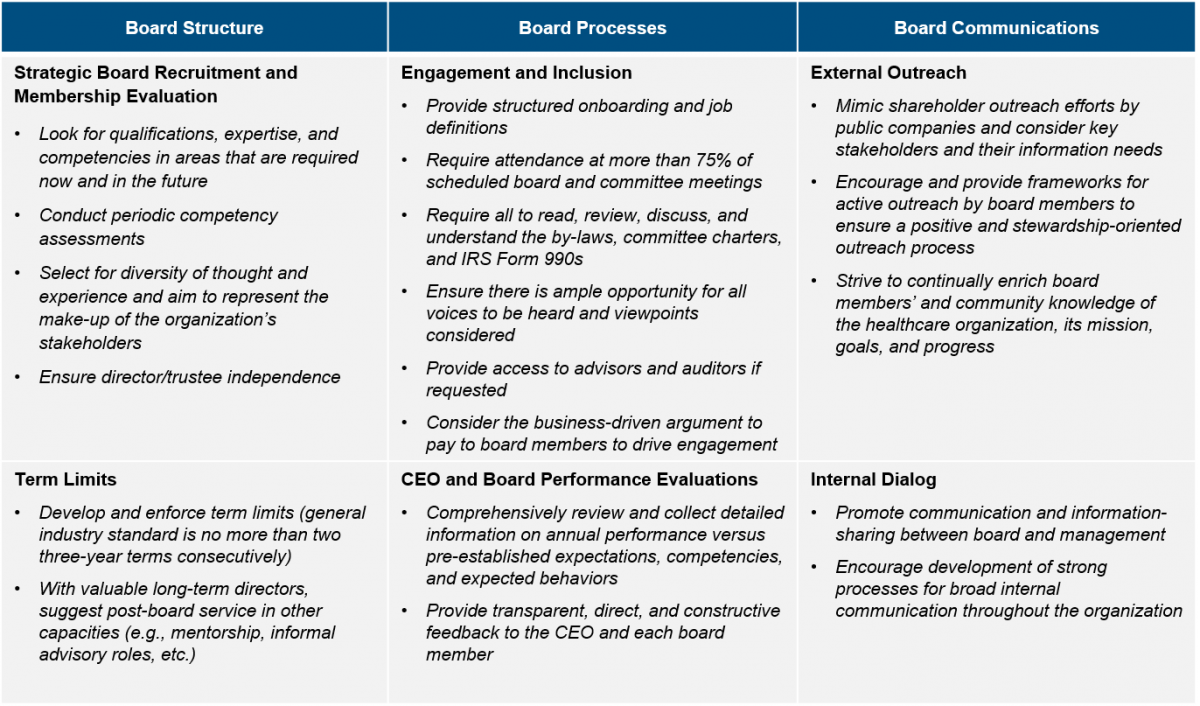
Advisor Blog | Feb 2022
The Unexpected Way Healthcare Organizations Can Make Beneficial Progress on ESG
All aspects of ESG goal-setting and measurement should flow through the governance arm of the board.
A topic of significant importance for directors and senior leaders in corporate America relates to “ESG” or environmental, social, and governance concerns. These non-financial categories and standards for organizational management, decision-making, and behavior are increasingly used by investors to identify material risks and growth opportunities. While ESG data is not commonly part of mandatory financial reporting, companies increasingly make disclosures about these areas and consumers are beginning to use this kind of information to make values-based decisions about where they spend time and money.
What does this broader business trend of evaluating ESG concerns mean for not-for-profit healthcare organizations? Is it a way to enhance the positive impact of healthcare providers? Can it sway public perception and by extension, become a competitive differentiation?
Implications for Not For Profit Healthcare
Since roughly 75% (or more) of healthcare providers organizations are tax-exempt, many of their boards and executives currently do not consider ESG to be directly relevant. However, as mission- and stakeholder-driven entities, there are opportunities for not-for-profit healthcare organizations to apply these concepts.
Business-Based
- Market Differentiation: Most health systems have relatively similar purposes, missions, articulated values, strategies, and organizational models. As a result, it is increasingly more difficult to compete on these traditional points. Adopting ESG-based principles can provide a different way to connect with consumers and possibly evolve into a more appealing healthcare organization from a reputational standpoint.
- Growth, Profitability, and Total Returns: Investment performance research indicates that companies that embrace ESG as part of their management practices financially outperform their peers. Down the road it is not beyond the realm of possibility to see adoption of these standards—or the lack thereof—impact health systems’ bond ratings and cost of capital.
- Organizational Agility: Embracing ESG also offers an operational benefit. The monitoring, tracking, and reporting mechanisms that are part of many ESG initiatives can enhance the speed and quality of decision making and action. This is particularly apt from a social impact and Human Capital Management perspective.
Community-Based
- Trust: Customers, employees, communities, donors, and other key stakeholders have some degree of choice when choosing providers, and they are demanding more transparency, fairness, equity, and collaboration. By setting and stating goals related to ESG, your organization can help establish trust and build a stronger relationship.
- Improved Outcomes: Many of the social aspects of ESG—promotion of diversity, equity, and inclusion or workforce health and safety—tie directly to the mission of improving community-based healthcare outcomes.
Considering the potential upside, it’s worthwhile for healthcare boards and senior leadership to learn about and closely examine the basic, overarching ESG frameworks. More public companies than ever are engaged in serious application and disclosure of ESG goals, metrics, and action plans.
Investigate how many of these criteria are already being used, and develop an understanding of where these ideas and metrics could be applied. How to implement ESG practices, much less “best practices,” is a dynamic and ongoing process.
Focusing on the “G” in ESG
While it’s perhaps less glamorous than its E and S partners, governance is clearly an area of responsibility for the healthcare board. Directors/trustees have an opportunity to set a “tone at the top” that can build a strong foundation from which to collaborate with management and strategically lead the organization. All aspects of ESG goal-setting and measurement should flow through the governance arm of the board.
The checklist below provides a starting point for discussions on board structure, processes, and communication.

Many new ideas and emerging practices related to ESG have a tangible benefit for not-for-profit health systems. They reflect major trends in global investment, social change, and the enhancement of transparency and communication. By diligently focusing on the more detailed aspects of governance—as the entry point for the organization’s long-range focus on other ESG issues—boards can forge a better relationship with stakeholders, as well as have a greater strategic impact on the health organizations they serve.
Healthcare plays a central role in our lives, communities, and the economy at large, approaching 20% of our Gross Domestic Product. Given that position, ESG-based concepts deployed within healthcare may offer an opportunity for substantial societal change and improve quality and efficiency within healthcare organizations. While still balancing the ongoing pandemic, health systems will begin to return to their complex “triple aim” initiatives to lower costs and increase value in the delivery of health and wellness services. Thinking about business strategy, ESG can be a tool to drive organizational transformation and enhance overall organizational health, produce competitive advantage, and sustainability.
There has never been a better time to take a new approach to how not-for-profit health systems and providers operate and communicate. Taking cues from the corporate world and incorporating ESG concepts offers some compelling benefits for the healthcare mission.